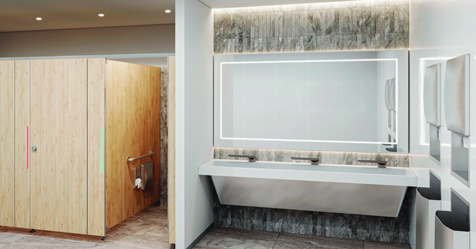It is a physiological part of the human condition; we always need a restroom nearby.
Thus, the rooms that many facility managers and contractors would rather forget can be found almost everywhere.
They are in the finest of restaurants and in the greasiest of spoons.
They are in state parks, on public beaches and even beside highways.
And regardless of the location, there is no overstating the importance of restroom cleaning.
Due to the nature of their use, restrooms frequently house some of the most difficult cleaning challenges — from odor and disinfection to discoloration and contamination.
One of the most troublesome restroom issues today is grout discoloration.
CMMOnline.com reached out a few experts and put together a trio of tips to help address this universal cleaning challenge.
Cleaning Grout Tip 1:
Bill McGarvey, director of training & sustainability for the Philip Rosenau Company and a Cleaning Management Institute certified trainer, said the first step is ascertaining the cause of grout discoloration.
If soil can be seen creeping up a wall in the grout lines, managers need look no further than the nearest custodian’s mop bucket.
Aside from troublesome mop buckets, managers should try to figure out what soil has discolored the grout and where it originates.
Next, to remove existing discoloration, an appropriate cleaning agent should be used to loosen the soil with proper agitation from a brush or a pressure washer using 1,000 PSI or less.
Once the soil has been loosened, recovery should be accomplished with a good-quality wet vacuum.
“Trying to mop up the dirty solution is merely going to start the soiling process again,” McGarvey revealed.
Finally, once grout is properly cleaned — or better yet when grout is new — it should be sealed with an impregnating sealer.
For heavily trafficked areas, the use of air movers and proper ventilation can help keep moisture, bacteria and contaminants from thriving in porous grout.
Cleaning Grout Tip 2:
Steve Schultz, a chemical engineer with Clorox who has 10 years of product development experience with cleaning products, stated that tough-to-clean urine stains and odors in restrooms can make an otherwise clean facility seem unappealing and dirty.
To properly address odors and discoloration, Schultz suggested the following:
- The effective and lasting solution to eliminating odors lies in breaking down uric acid crystals and removing the source of the odors rather than just masking them.
- Porous damp surfaces, such as grout, hold bacteria, which feed on urine in humid conditions, and wetting the surface can reactivate the odor. To combat this, look for products that work on hard and soft surfaces and incorporate them as a regular part of your cleaning routine.
- Use hydrogen-peroxide-based cleaners for removing both stains and odors.
Porous surfaces not only trap odor-causing bacteria and urine, but they also are susceptible to stains.
Feature: Advances In Restroom Care
To eliminate urine stains, Schultz suggested looking for products with surfactants that penetrate deep into surfaces to reach and break up the cause of stains.
Cleaning Grout Tip 3:
Anthony Melchiorri, also known as the “hotel fixer,” and Dave Mesko, senior director of marketing for Cintas, addressed hotel and motel restrooms.
For tile in guest restrooms, they recommended the use of deep cleaning services to make sure grout lines are free of buildup and odor-causing contaminants.
Between these deep cleanings, hospitality managers can maintain high levels of cleanliness by providing the appropriate tools and supplies for their housekeepers.
Melchiorri and Mesko recommended fully-stocked cleaning carts with chemicals to help housekeepers efficiently tend to guest rooms.
One suggestion they provided was the installation of a chemical dispensing unit in the housekeepers’ storage areas on each floor.
These units ensure the correct cleaning dilution is mixed each time and can limit employees’ contact with irritating chemicals.
From chemicals to scrubbers, a number of tools stand ready to help cleaners battle restroom grout issues.
Though it is one of the cleaning industry’s biggest challenges, proper product use and employee training can help managers and contractors win the war against dingy, dark grout.


